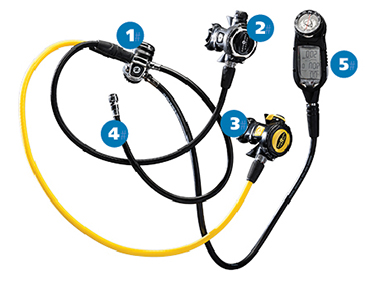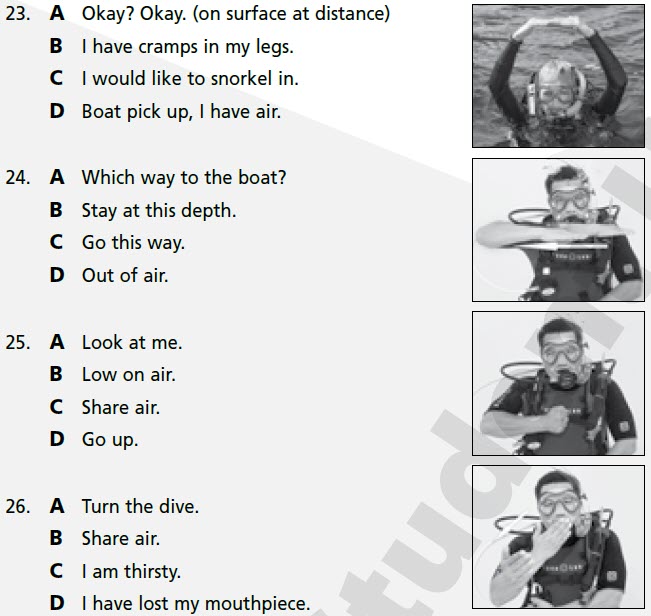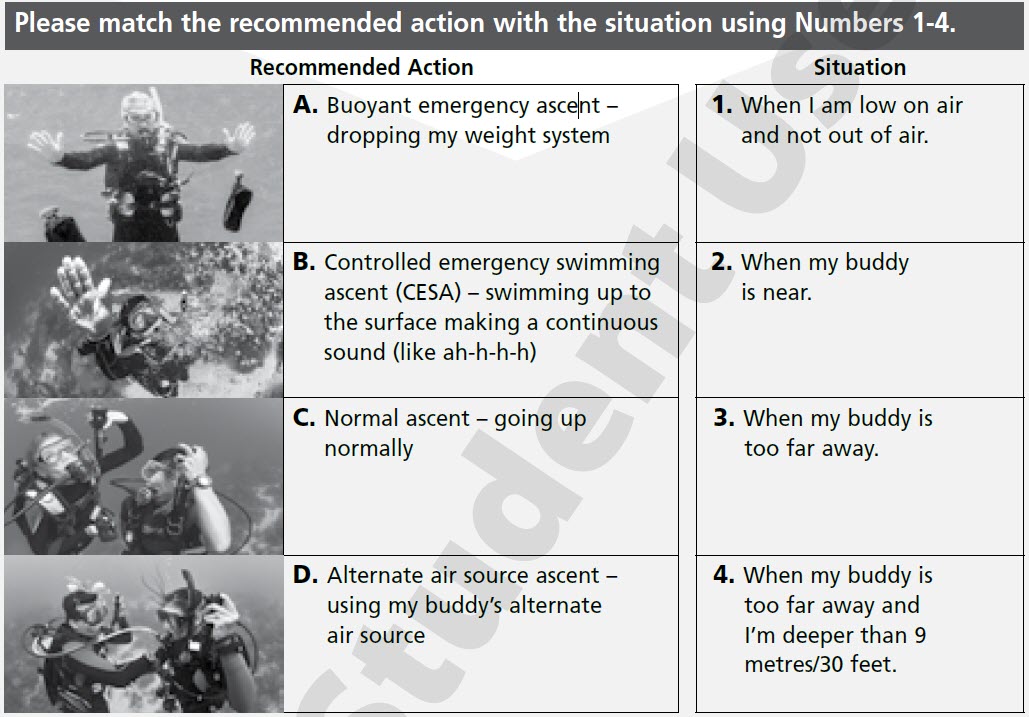
Lesson 152
Exam Answer Sheet
Download the answer sheet. Use the answer sheet to record your answers. Exam questions are below.
Once you have completed the exam email it to your instructor
Final Exam - 50 Questions ( no time limit)
1. If an object is neutrally buoyant (does not sink or float) in fresh water, the same object placed into salt water would
A - sink.
B - either sink or float.
C - do nothing.
D - float.
2. I blow up a balloon, tie it off, and take it to the bottom of the swimming pool. What will happen to the balloon and the air inside it?
A - The balloon will get bigger and the air inside the balloon will be less dense (molecules move further apart).
B - The balloon will get smaller and the air inside the balloon will be more dense (molecules move closer together).
C - The balloon will get bigger and the air inside the balloon will be more dense.
D - The balloon will get smaller and the air inside the balloon will be less dense.
3. I turn a glass upside down, trap the air in it by putting it in water, and then I take the glass down to 10 metres/33 feet. The air space would
A - become half the size it was at the surface.
B - not change in size.
C - become 1/3 the size it was at the surface.
D - become 2/3 the size it was at the surface.
4. If I am not able to equalize (clear) my body air spaces, it may be
because I have
A - seasickness.
B - heart disease and high blood pressure.
C - a cold, allergy or another medical problem.
D - anxiety.
5. If my ears or sinuses hurt while I am descending (going down), it usually means
A - my air spaces are equalized.
B - my mask strap is too tight.
C - I am feeling a squeeze and need to clear.
D - my mask is too small.
6. The best place for me to position an alternate air source is:
A - loose by my side
so I can find it fast.
B - in the triangle area formed by my chin and the lower corners of my rib cage.
C - to the base of my cylinder.
D - to the back of my BCD between my shoulder blades and waist.
7. Lung overexpansion injuries can be caused by
A - scuba diving without a buddy.
B - continuing a dive when not properly weighted.
C - not drinking enough water before scuba diving.
D - holding my breath while scuba diving.
8. If my cylinder of air lasts 60 minutes while I am at the surface breathing normally, assuming all else is the same, how long will it last at 20 metres/66 feet breathing normally?
A - 60 minutes
B - 20 minutes
C - 15 minutes
D - 12 minutes
9. How often should I take my scuba cylinder to be visually inspected by my dive center?
A - Once a year.
B - Once every two years.
C - Every six months.
D - Every five years.
10. The difference between DIN valves and yoke valves is that DIN valves
A - are made from durable plastic.
B - contain a spring-operated shutoff valve that is held open by cylinder pressure.
C - have an o-ring in them.
D - have threaded openings to screw the regulator into.
11. Which of the following is part of proper care for my scuba cylinder?
A - Sand and repaint it every year.
B - Dry it in the sun.
C - Keep some air in it.
D - Have it pressure tested every month.
12. Look at the regulator picture. Each regulator part has a number next to it.
Write the number of the part next to its name
Number _______ low pressure inflator hose for the BCD
Number _______ instrument console/computer
Number _______ regulator second stage
Number _______ regulator first stage
Number _______ alternate air source second stage
Number ___6___ (Example) alternate air source hose

13. When I look at things underwater they often seem _________ than they look on the surface.
A - larger and/or nearer
B - larger and/or further away
C - smaller and/or further away
D - smaller and/or nearer
14. ____________ travels faster in water than it does in air. This is why you cannot easily tell where it comes from.
A - Light
B - Current
C - Aquatic life
D - Sound
15. Unless there are laws that say differently, I should stay within _______ of my dive flag.
A - 60 metres/200 feet
B - 30 metres/100 feet
C - 15 metres/50 feet
D - 5 metres/15 feet
16. If I work too hard and find it difficult to breathe underwater, I should
A - inflate my BCD.
B - stop all activity and rest, holding onto something for support if possible.
C - swim immediately to my buddy and signal for help.
D - do a controlled emergency swimming ascent (CESA – swimming up to the surface saying the ah-h-h-h sound).
17. As I descend (go down), my wet suit will
A - compress (feel thinner) from water pressure, and I will lose buoyancy and warmth.
B - expand (feel thicker) from water pressure, and I will gain buoyancy and warmth.
C - remain the same thickness from the water pressure, and there will be no change in warmth.
D - expand (feel thicker) from water pressure, and I will lose buoyancy and warmth.
18. I know I am properly weighted for diving if I ...
A - Float at neck level with a half full BCD with a normal breath of air.
B - Sink slowly holding a normal breath of air and with an empty BCD.
C - Float at eye/forehead level while holding a normal breath of air and with an empty BCD.
D - Sink easily with a partially filled BCD.


27. If I were separated from my buddy the general procedure is to
A - go up immediately, wait a minute and then go back down.
B - search for a minute and then go up to reunite with my buddy at the surface.
C - go to the surface immediately and get out of the water.
D - look for my buddy’s bubbles and follow the bubbles to find my buddy.
28. I am most likely to become confused about which way is up or down _________.
A - at the surface
B - near the surface
C - on the bottom
D - in midwater
29. I feel a mild current at the start of my dive. How should I begin this dive?
A - Dive with the current.
B - Dive across the current.
C - Dive against or into the current.
D - Dive at an angle to the current.
30. What the bottom is made of can cause big changes in
A - visibility (how far you can see underwater).
B - temperature (how warm the water is).
C - current (the movement of water).
D - buoyancy (whether you sink or float).
31. Most injuries caused by aquatic animals happen because the animals are
A - hungry.
B - curious.
C - injured.
D - trying to defend themselves.
32. A diver at the surface is moving quickly and jerkily, has the mask off the face, the regulator/snorkel is out of the mouth, and the diver does not respond to directions. The diver is
A - giving the okay signal.
B - performing a predive safety check.
C - excited about the dive.
D - showing signs of distress (trouble).
33. I am close to my buddy and realize I am out of air. The best response is to
A - switch to my buddy’s alternate air source.
B - make a controlled emergency swimming ascent (swim up to the surface making a continuous sound, like ah-h-h-h).
C - make a buoyant emergency ascent (dropping my weight system).
D - switch to my buddy’s alternate air source and continue the dive.
34. If my regulator begins to free flow (release air continuously) while underwater, I should
A - make a controlled emergency swimming ascent.
B - do nothing special.
C - hold the regulator without sealing my mouth around the mouthpiece and “sip” the air I need as I ascend (go up).
D - make a buoyant emergency ascent.
35. If I were very low on air and about to run out, what would I do?
Example:
What number would you put for A? (Choose from the Situation Column)
Continue for each one.

36. There is an injured diver who is out of the water and is not responding to touch or my voice. The first thing to do would be
A - to check if the diver is breathing.
B - to keep the diver warm.
C - to decide what happened.
D - to provide oxygen.
37. I should have cylinders filled at a dive center I trust, not use air that tastes or smells bad, nor use air from a compressor designed to fill car tires. This is important to
A - decrease the likelihood of gas narcosis.
B - increase the enjoyment of my dive.
C - reduce the risk of lung overexpansion injuries.
D - reduce the risk of breathing contaminated air.
38. Divers who act foolishly at depth due to gas narcosis may start acting normally again if they
A - ascend (go up) to a shallower depth.
B - breathe slowly and deeply.
C - signal their buddy for help.
D - dive within no stop limits.
39. I am likely to increase the risk of decompression sickness (DCS) if I
A - dive in poor visibility, strong moving water, and rough seas.
B - dive while tired, cold, sick, thirsty or injured.
C - do not look after my equipment.
D - am using a dive computer.
40. If I think I have decompression sickness I should
A - stop diving until I feel better.
B - go back in the water.
C - breathe 100 percent oxygen and contact emergency medical care.
D - see a doctor when I can.
41. The first step in using my dive computer is
A - setting the time and date.
B - reading the manufacturer’s instructions.
C - calibrating it for enriched air nitrox.
D - setting it for fresh or salt water.
42. When planning a dive with a computer, I use the “plan” or “no stop scroll” mode to determine:
A - the maximum depth of the previous dive.
B - the maximum allowable time limits for depths (typically in 3-metre/10-foot increments).
C - whether my computer is compatible with my buddy’s computer.
D - the best settings for my backup computer.
43. When making computer assisted dives
A - each diver needs a personal computer.
B - each buddy team needs a computer.
C -up to four divers may share a computer.
D - all divers may follow the dive guide’s computer.
44. It’s important that I do not turn off a dive computer between dives because
A - the divemaster may object because I can’t recall the dive information for logging.
B - it would lose memory of the previous dive and not calculate repetitive dives correctly.
C - it won’t come back on, or it may take a long time to power up.
D - doing so is hard on the batteries and may cause the computer to fail.
45. If I accidentally exceed my computer’s no stop limits, I should
A - make a safety stop for three minutes at 5 metres/15 feet.
B - follow the computer’s instructions for decompression.
C - surface immediately, breathe oxygen and report my condition to the divemaster.
D - make a controlled ascent and refer to the manufacturer’s literature for decompression procedures.
46. If I’m diving in cold water or under strenuous conditions
A - Nitrogen absorption will be slower so I can stay longer/
B - I should add and extra safety margin and stay well within my computer's limits.
C - my dive computer will probably not work at all.
D - I do not need to do anything special.
47. If my computer fails during a dive, I can use my backup computer to continue the dive. If I’m not wearing a backup, I should
A - ascend (go up), make a safety stop and end the dive.
B - borrow my buddy’s backup.
C - continue the dive until low on air, but make no repetitive dives.
D - end the dive and surface immediately.
48. I make two dives in one day and am flying home on a commercial plane. I should wait until my computer says I can fly or ________ hours, whichever is longer.
A - 0
B - 48
C - 24
D - 18
49. As a new PADI Open Water Diver, the recommended maximum depth is _____________, or the actual depth I reached in training, if shallower. The maximum depth for all recreational scuba divers, even experienced divers, is _____________.
A - 10 metres/30 feet / 18 metres/60 feet
B - 12 metres/40 feet / 30 metres/100 feet
C - 18 metres/60 feet / 40 metres/130 feet
D - 24 metres/80 feet / 58 metres/190 feet
50. When diving at an altitude above 300 metres/1000 feet
A - I do not need to follow special procedures.
B - I can’t use my dive computer.
C - I do not need to follow special procedures, but my computer may need to be set for the altitude.
D - I need to follow special procedures and may need to set my computer for the altitude
Comments


